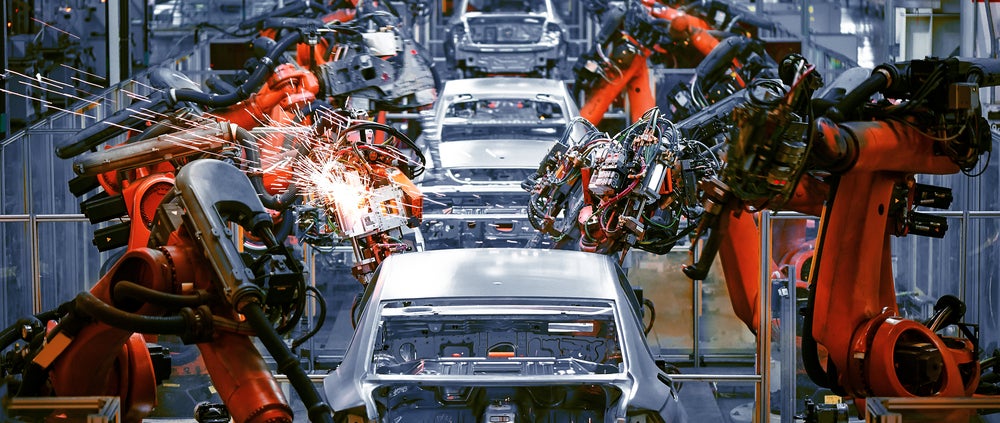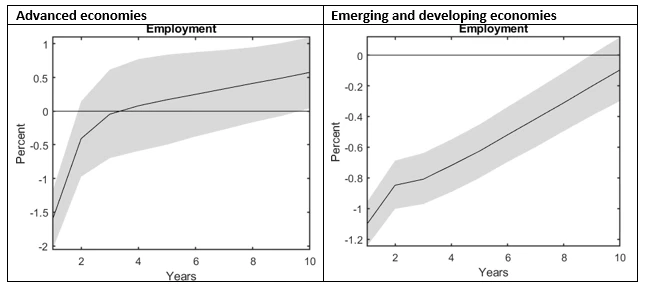 © Jenson/Shutterstock
© Jenson/Shutterstock
Productivity-enhancing technologies are vital to raising national income and reducing poverty. However, some new technologies are labor-saving and reduce the need for workers in some production processes. At the same time, if the rise in incomes generated by more efficient production creates demand for new jobs and tasks, the effect of new automating technologies on employment may be neutral, or even positive over time. The net effect of new technologies on employment, which is also likely to vary over different time horizons, is the subject of great debate, and a new working paper (Kindberg-Hanlon 2021) studies the effects of productivity-enhancing technologies on aggregate employment.
History can offer lessons in how the incorporation of new technologies into the production process has affected employment. Using a new structural vector autoregression (SVAR) approach, long-lasting productivity changes are identified across a large sample of over 100 economies over 1981-2018 on average in emerging market and developing economies (EMDEs) and over 1973-2018 in advanced economies, allowing an examination of their effects on aggregate employment.
How does employment respond to lasting aggregate productivity improvements?
Long-lasting labor productivity improvements captured in this SVAR framework could result from improved technological efficiency in combining both labor and capital inputs in production. Equally, new technologies may allow for the replacement of tasks previously completed using manual labor with capital, or “robot” inputs, reducing employment (Acemoglu and Restrepo 2018). The initial impact on employment estimated in the SVAR can be used to determine whether the typical technology introduced over the sample has involved the replacement of tasks. Longer-term, the response of employment demonstrates whether workers have transitioned to new tasks, and how the net impact changes over time.
Figure 1: Employment effect of productivity-enhancing technology (10% boost to productivity)
The results suggest that over the last 40 years, productivity improvements have been initially labor-displacing on average (Figure 1). In advanced economies, employment fell by nearly 2 percent following the introduction of new technologies that boosted labor productivity by 10 percent over the long run. After 4 years, the impact became modestly positive for employment, but not statistically significant. In emerging market and developing economies, employment losses were smaller, at 1 percent, but more persistent, lasting close to 10 years before the losses dissipated. This suggests that advanced economies more frequently introduced labor-saving technologies than EMDEs, but that the reallocation of workers to new roles was a slower process in EMDEs.
What are the characteristics of economies with larger or smaller employment losses?
In individual-country estimations, about three-quarters of economies experienced job losses in the first year following the introduction of productivity-enhancing technologies, but the scale and persistence of job losses varied. Over the subsample since 1990, economies where a larger share of workers were in industrial (primarily manufacturing) roles have shown larger and more persistent job losses from new technologies, while those that have been better able to reallocate workers to less affected sectors, such as services, have smaller initial losses and faster recoveries.
This finding corresponds with evidence that job losses from automation have been most concentrated in the manufacturing sector in recent decades. In the United States, employment of machine operators, assemblers, and other production employees fell by over one-third every 10 years between 1980 and 2005 (Autor and Dorn 2013). In a study of 16 European economies during 1993-2010, the share of employment accounted for by middle- and low-skilled industrial sector occupations fell by nearly 10 percentage points (Goos et al. 2014). In the United States and France, the increased use of robotics in industry was inversely related to industrial employment levels since 1990 and 2010, respectively (Acemoglu et al. 2020; Acemoglu and Restrepo 2020).
Even where new automating technologies generated higher incomes and demand for new products, these gains tended to be spent on service sector output (Comin et. al. 2015), such that employment was unlikely to recover in the sector that had been exposed to the greatest degree of automation, the industrial sector. This may explain why those economies that have remained more concentrated in the industrial sector in recent decades have suffered larger employment losses following labor-displacing technology shocks: automation in these economies has either not been associated with large income effects that boost employment in the services sector, or a lack of transferable skills has prevented labor reallocation to newly-demanded tasks.
Figure 2: Employment losses following the introduction of productivity-enhancing technologies in economies with high and low industrial concentration since 1990
How can policymakers respond?
This analysis has examined historical relationships. However, several studies find a pronounced risk from new technologies to employment in the future. Arntz et al. (2016) find that 9 percent of jobs across 21 OECD economies are at high risk of automation in the future. A broader study of 32 economies, including several EMDEs, has found that on average 14 percent of jobs are at high risk of automation, particularly in the manufacturing sector (Nedelkoska and Quintini 2018). Increasingly, many service sector roles are likely to also become at risk of disruption, particularly due to the outsized impact of the COVID-19 pandemic on service sector industries. In a global World Bank survey of firms, 34% have increased their use of digital platforms in response to COVID-19. A survey conducted by the ECB found that 55 percent of firms expected the pandemic to have a negative long-term impact on employment, while 60 percent thought there would be a positive long-term impact on productivity.
Policies that help enhance workforce skills and educational attainment could potentially reduce the fall in employment following the incorporation of labor-displacing technologies. Many EMDEs will need to make improvements at earlier levels of education to build a foundation for more advanced levels of education that will adequately complement new technologies (World Bank 2019).
For workers displaced from industrial roles, supply-side policies to improve skill matching may take decades. Directly increasing demand for industrial sector public goods could offset some employment losses. Substantial investment requirements have been identified in both advanced economies and EMDEs to meet climate and poverty reduction targets, particularly in infrastructure investment. For example, the European Commission has estimated that investment amounting to 2% of European Union GDP would be required each year to meet current climate and energy targets by 2030 (European Commission, 2020). Rozenberg and Fay (2019) find that EMDEs may need to invest between 2 and 8 percent of GDP each year, primarily in infrastructure for energy, sanitation, agriculture, and transportation to meet the United Nation’s Sustainable Development Goals by 2030.




Join the Conversation